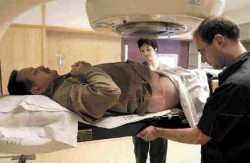BPH Treatment
 Treatment for enlarged prostate can take many different directions depending on symptom severity and how much the gland changes over the short term. The size and consistency of the gland can indicate a turn for the worse should the gland expandsand lost its rubbery texture. These conditions are easily monitored by a physician. However, most occurrences of prostate cancer will be missed in its early transitional stages from a benign enlargement condition is due to patient neglect to have themselves screened and routinely checked out for prostate disorders once symptoms become detectable.
Treatment for enlarged prostate can take many different directions depending on symptom severity and how much the gland changes over the short term. The size and consistency of the gland can indicate a turn for the worse should the gland expandsand lost its rubbery texture. These conditions are easily monitored by a physician. However, most occurrences of prostate cancer will be missed in its early transitional stages from a benign enlargement condition is due to patient neglect to have themselves screened and routinely checked out for prostate disorders once symptoms become detectable.
Treatment Options for LUTS. Lower urinary tract symptoms may be severe enough to require hospitalization. Severe restrictions or blockage of the urethra will make urination painful and near impossible without catheterizing the urine passage. In such conditions, patients will be encouraged to refrain from using any kind of OTC decongestants which can hamper the function of the bladder sphinctral muscles and keep these from opening with regularity and efficiency. Should urine retention symptoms be considered non-acute, patients will be encouraged to increase their body temperature by controlling their environment and increasing their circulation with body movement and exercising. They will also be instructed to restrict or exclude any alcoholic beverage intake. Sometimes bladder irritation can co-exist with other LUTS. Spicy food intake should be restricted. Doctors will also recommend regulation of fluid intake at night to reduce night time urination trips that disrupt sleeping patterns.
Cautious Awareness. Doctors usually recommend that patients with a BPH diagnosis considered mild should be watchful over their symptoms. Lifestyle is key. If changes need to be made, this is the time to get these in place to keep symptoms from progressing into moderate severe ranges of intensity. In the mild symptom range, natural remedies have more lasting effects on symptoms. Reducing intakes of spiced foods, eliminating excessive alcohol intake (daily drinking), and caffeinated beverage cessation are all common recommendations by physicians for their BPH patients. Should patients be unable to make these changes on their, it suggests a need for therapeutic support from a mental health professional to address lifestyle changes for the sake of health.
When Drug Treatment Fails. Moderate symptoms can be treated with drug regimens to reduce prostate size and urethral complications. Techniques for reducing prostate size by shrinking glandular tissues will relieve BPH symptoms. The general approach is to use either microwave heat to destroy excess prostate tissue, or to apply radio waves to burn off a defined portion of the gland.
Surgical Triggers. When BPH symptoms progress to the point where there is a recurrence of one or more urinary tract symptoms, surgery may become necessary. The most critical trigger is impending kidney failure. A urinary system that is consistently “backed up” will cause infection that can damage kidney tissue to the point of renal failure. Less severe, but damaging over time, is recurring urine retention in the bladder due to incomplete urination discharge, blood in the urine from irritated bladder and/or urethral tissue, and bladder deposits (stones).
A BPH diagnosis that advances with the continued enlargement of the gland to the point of making symptoms more severe and more of an impediment on patient quality of life, will precipitate the need to surgically reduce the size of the gland. There are different options depending on the affected areas of the urinary tract. If the urethral restriction is severe enough the tunnel through which the urethral tube passes needs to be enlarged. A transurethral resection, known as TURP, will remove part of the prostate to accomplish that enlargement goal. Sometimes the connection between the urethral tube and the bladder is acutely restricted causing a need to make a cut in the bladder neck. This is known as A TUIP procedure. Electro vaporization is another tissue removal process that can provide symptomatic relief of BPH. To the extreme, prostate removal may be the only recourse.
